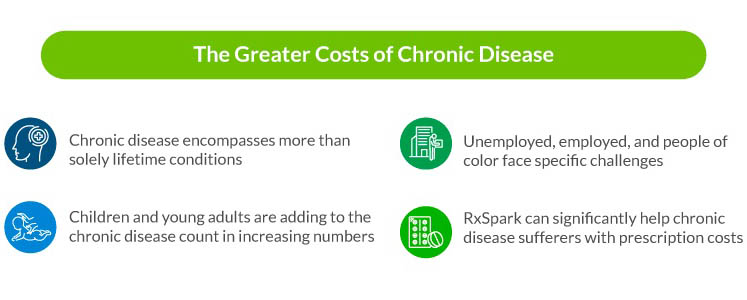
Learn more about how chronic diseases have significant direct and indirect costs for Americans of differing income levels and circumstances
Chances are, most of us have experience – whether ourselves or someone we know – in dealing with a chronic ailment, such as heart disease, type 2 diabetes or alzheimer’s disease. A 2021 study found that 19% of U.S. adults – almost 1 in 5 – reported having a chronic medical condition, while 15% reported having two. The personal cost is high in terms of physical, psychological, and financial strain if the health conditions persist over an extended period. This makes it essential to find ways to minimize healthcare spending without compromising health, such as purchasing essential prescription drugs at the lowest possible prices .
Furthermore, chronic health conditions don’t just affect U.S. adults. The American Action Forum highlighted in 2020 how the prevalence of chronic conditions is expected to increase and is already on the rise among the child and younger adult demographics, with an estimated 84% of national health costs dedicated to treating chronic diseases. This manifests as a total cost for chronic disease of $3.7 trillion for America, close to 20% of the country’s gross domestic product.
The term “chronic” doesn’t always apply to a prolonged health conditions, such as hypertension and type 2 diabetes. Any disease lasting three months or longer can qualify. For example, mental health conditions such as depression fall into the “chronic” category and the diagnoses may be transient, prolonged, or recurring. This guide will highlight how the economic costs of these conditions can financially impact different individuals.
The economic burden of chronic disease to patients
Medical expenditure for chronic conditions don’t exist in a vacuum for individuals, of course. The direct costs of medicating their chronic disease competes with other necessary expenses such as groceries, utilities, transportation, education, and rent or mortgage.
Non-medical expenditure could also interfere with (or entirely preclude) the payment of health insurance premiums, leaving patients with skyrocketing health care costs. These compounding costs only deepen the sufferer’s stress and may lead to financial sacrifices between day-to-day and medical needs. This could include eating less, being too hot or cold at home, or skipping some prescriptions to ensure taking those of a higher priority.
One nationwide poll revealed that as many as 18 million Americans couldn’t afford their prescription drugs – a percentage that increases the lower the household’s income. A 2020 survey found that 20.6% of people had skipped medications at least once due to high costs, with 13.1% having done so twice and 10.6% having done so more than three times.
These financial survival tactics can quickly affect someone’s quality of life while exacerbating any existing health problems and leaving sufferers needing additional visits to healthcare providers they can’t afford – 46 million Americans already can’t meet the cost of necessary healthcare services.
The health economics of unemployment and low pay
The impact of chronic disease can also affect U.S. adults’ ability to work, rendering any degree of financial comfort even harder to achieve. And having employment doesn’t necessarily mean it’s that much easier to cover medical care either. The many Americans earning minimum wage will struggle to cope with an expected 5.2 percent increase in employees’ pharmacy and medical costs this year.
High employer deductibles can make it just as challenging for working people with chronic diseases. Pick any wage bracket under $40,000 a year and you’ll find that people have delayed or gone without treatments due to high medical costs, with dental, vision, and doctor services topping the visits avoided .
One study conducted by the Commonwealth Fund found that middle-income Americans (those earning from two-thirds to double the median income of $44,225 ) with employer coverage are hit particularly hard by physician coverage costs. This can be because their employer’s physician or network of physicians isn’t sufficient for the patient’s needs, forcing them to seek out-of-network healthcare providers, which is more expensive and drives up out-of-pocket costs.
Many Americans work multiple jobs to make ends meet – an undertaking that carries multiple risk factors of its own, such as obesity, diabetes, high blood pressure and elevated stress. This approach may seemingly allow more money for prescription expenses but with the cost burden of these additional health conditions, that can defeat the purpose. The negative financial spiral can worsen as people with chronic diseases try other initiatives to supplement income to meet medical ends: draining their savings, taking out loans, or increasing credit card debts.
These sacrifices and compensations fuel a vicious cycle that adversely affects some chronic condition sufferers more than others. People of color, for instance, typically suffer higher unemployment, so those with chronic conditions such as cardiovascular disease and type 2 diabetes, find it harder to find the kind of health coverage that could help pay for medications. It’s barely an exaggeration to call the pressure of medical costs a chronic condition in itself that only adds to the strain affecting millions. This is why working with a partner who can save you every dollar possible is one of the healthiest moves you can make.
Connect with ModRN Health to make chronic conditions less financially stressful
Easy access to well-priced prescription drugs makes it simpler for people to manage their conditions, maintain their quality of life, and remain as healthy as possible. This is where ModRN Health shines. Our service can help save Users an average of $500 annually on prescription drug costs, and this price reduction leaves more in your pocket for other health care expenditure or day-to-day expenses.
We’re not insurers, but our prices may be even lower than your current insurance copay and could save you up to 80% at participating pharmacies. Users also get Rewards Points for signing up, for filling prescriptions through our service, and when anyone they refer fills prescriptions through our service.
Visit our site today to learn more about our mission to make prescriptions less stressful for everyone. You can find a better price for your meds and see firsthand how ModRN Health can help make managing your chronic conditions less costly.








